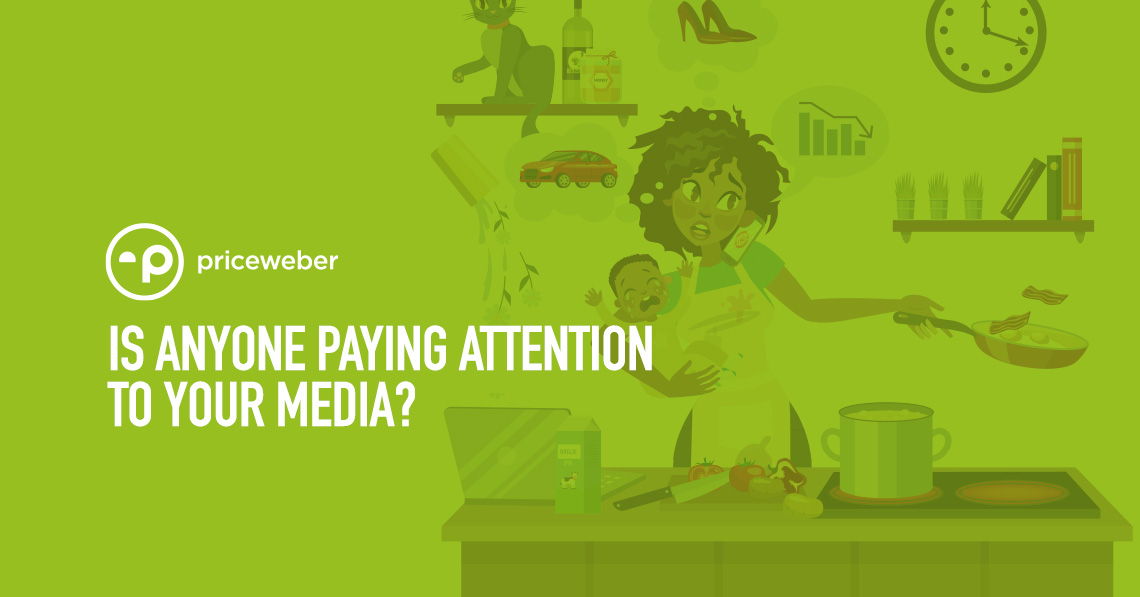We’ve all heard more than once that people today are overstimulated with information, and their attention is stretched thin. We all feel it, too – the subconscious tug of a thousand different things vying for our attention. In a single morning in a household like mine, kids are repeatedly asking the whereabouts of their favorite toy, scarf, pair of socks or whatever. The TV is on while breakfasts are doled out, lunches are packed, and counters are climbed on (sometimes for the 3rd time). We’re on the phone, trying to check the weather, prepping for the workday, and getting kids off to school and all the while being hammered with ads on TV, the car radio, the cellphone and the laptop. And it’s not our imagination either. The latest statistics show that in addition to being overscheduled, the average adult is exposed to between 4,000 and 10,000 advertisements each DAY. Attention is a valuable commodity, and sometimes there isn’t enough to go around, so in today’s Plain Talk, we’ll pay attention (get it?) to just how we can make sure your ads can break through.
The economics of attention
Advertisers and brands have been fighting over consumer attention since the beginning, but the idea of attention economics became more popular in the 90s. It’s based on simple supply and demand, viewing one’s attention (to information, data, or content) as a resource with a limited supply. In an effort to boost the success of products or services, we see advertisers working harder with their messages to capture a fraction of a person’s time (ahem … we see you clickbaiters, shock jocks and promo-crazy stores). They know that gaining someone’s attention is a critical – and literally the first step – in the marketing funnel. If no one sees (and pays attention to) your ad, it’s like it never ran. You can’t possibly gain someone’s interest, consideration and “need,” and you definitely can’t get them to take any action until you’ve achieved that first critical step.
When people think about the act of capturing a person’s attention in advertising, they often think about just the creative messaging and the visual output. While that is a key piece, there is another less talked about element to keep in mind, and that’s the type of media where the message lives.
Attention measurement
Before we can talk about media planning and capturing attention, we need to acknowledge that attention is not an easy thing to measure. To this point, most of the measurement metrics we receive focus on visibility, engagement, impressions (how many times your ad could have been seen vs. how many times it was actually seen). Obviously, outcome-based metrics (clicks and conversions) are also measured as much as possible and give an indication of how well the advertising is working compared to the end goal. While there are companies that are measuring and researching attention in media, it’s not widely available, can be costly to do well, and currently, you can’t use any of these attention metrics as a currency or bartering tool in your negotiations (although we think that will change soon). Still, the research that companies like MOAT, TVision and Lumen Research are doing provides some insight into how we can be more efficient at delivering consumer attention and ultimately increase the outcomes of our campaigns.
Attention in media planning
Great media planning and buying require the ideal blend of art and science. On the science side, there are very real and useful metrics (cost per 1,000 impressions, cost per click, cost per conversion, conversion rates, etc.) that help guide and optimize all good media plans. We collect and use data to figure out who our target audience is and which media they regularly use. But the other side – the art of media planning – requires us to find and interpret meaning in the data so we can best use it. The success of your brand’s advertising boils down to how well you can reach your customer and how relevant you are when you do. So how can we maximize our ability to capture their attention with our media placements?
1. Remember the 5 Ws: who, what, when, where and why?
Understanding your customer is the first step in any good media plan. Most people know this in theory, but a lot of people place a priority focus on the who and the what, ignoring in some cases the when, where and why. In planning, it’s important to learn and absorb not only their demographics or what media they spend the most time with but take a step back and ask yourself: what are they doing while they are exposed to advertising, where are they, what is their objective (research, entertainment, curiosity).
Early morning news and weather typically garner decent ratings, so it may be efficient, but it’s not generally “appointment TV.” For parents, mornings are filled with multitasking, juggling responsibilities, and ultimately, shoving a pop tart in your bag and rushing out the door. If you aren’t paying attention to the screen, it lowers the opportunity to gain your attention with the ad. Alternatively, live sports and some prime programs are can’t-miss. Even your ad placement within a commercial pod can be improved – running in the first or last commercial spot in the break increases the likelihood people are paying attention to the screen and actively viewing content.
Someone who works a night shift, like a nurse or plant worker, probably won’t be watching that live sports game or that must-see prime program. The morning news and the beginnings of daytime TV may be their focused quiet time, or perhaps reaching them early in the afternoon before they head back to work.
Research shows senior citizens are more attentive in the morning, so if you’re running Medicare enrollment ads with a call-to-action, time of day might be a significant consideration.
Another often-overlooked place to capture attention is when people are in their car. If they are driving, there is only so much they can do WHILE driving. While people often relate attention to visual stimuli, you can, of course, also gain attention with audio.
Lastly, we need to accept that multitasking is a standard practice. There are ways we can work with that using advanced TV retargeting where ACR technology can identify when an ad has aired on TV (measured on smart TVs only). Because people are often on their phones while watching TV, this tactic will serve a follow-up ad on their phone when your ad or a competitor’s ad air, increasing the likelihood of gaining their attention. Additionally, audio retargeting can provide that visual element later, when someone is scrolling on their phone, so that even if they aren’t fully attentive while listening to Spotify, we may be able to recapture their attention later.
2. Consider attention in determining the efficiency of specific parts of the plan … but remember it’s just one consideration.
Ultimately, we focus on the tactics that drive results. But sometimes, at the onset of planning, we look to impressions served and CPM (cost per 1,000 impressions). But, when we factor in attention, it may shift the scales towards a tactic you didn’t think would fit. In the TVision/Lumen Research study, they estimated that 75% of TV ads are viewable, but only 43% of those ads are viewed for an average of 13.8 seconds. On the other hand, nearly everyone on YouTube or social media has viewable ads regularly appearing as part of their content experience, but these ads typically generate less attention (only 5 seconds for YouTube ads and under 2 seconds for social media). Facebook may have a lower CPM than TV but may be less efficient at delivering attention.
Of course, these findings are very top-line and will vary based on the audience you want to reach. They don’t mean that every campaign must include TV. There are still other things to factor in – you may need increased tracking from click to website engagement. Your audience may not watch much TV (cutting down your reach). There could be a tactic that is less efficient at attention but more efficient at driving business outcomes. So maybe instead of traditional TV, you use OTT or pre-roll video. If Facebook is your #1 conversion driver, optimize within Facebook. Incorporate stories ads instead of relying solely on the newsfeed ads, as those tend to get more attention.
3. Remember that not all attention is created equal and ad performance varies over time.
Ad performance is never a static thing, and media is not a “set it and forget it” tool. There are always adjustments to be made, whether that’s due to creative, market factors, performance plateaus, or just changes in product promotion. Attention also varies throughout the day, week, and year. While adjustments can be made to the media plan to accommodate for shifts, we also need to consider the creative. If we have strong performing creative that does a great job of capturing attention, it’s probably also going to wear out a little quicker. On the other hand, if you have creative that isn’t performing to your liking, it may be that the messaging needs a little more frequency to show a positive impact.
Still with us?
Hopefully, we’ve given you some useful pointers to consider when thinking about how to make media decisions. We believe the psychology of attention and memory in marketing can really help center how businesses think about advertising, so keep an eye out for more content on the subject. Of course, if you can’t wait and you have some burning questions about media and attention, please give us a call at 502-499-4209 or drop us a note here, and we’ll be happy to help.



